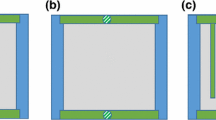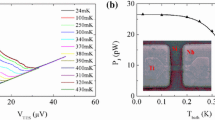Abstract
Superconducting microcalorimeters based on transition-edge sensors (TESs) are being successfully used in applications ranging from optical photon counting to gamma-ray and alpha particle spectroscopy. Practical instruments often require a complex optimization among speed, linearity and energy resolution. However, a lack of understanding of the superconducting transition limits our ability to predict the behavior of a new TES design. Specifically, there is an unmet need for a model that predicts the current and temperature dependent resistance surface that describes the transition: R(I,T). This paper describes the predictions of a two-fluid model for the resistance of a TES based on a Ginzburg-Landau form of the critical current. We compare the predictions of the model for the logarithmic derivatives of resistance with temperature and current (α and β) to measurements of TESs used in x-ray and gamma spectrometers. The model shows excellent qualitative agreement that provides useful insight into the dependence of α and β on the current density and bias point of the TES.



Similar content being viewed by others
References
K.D. Irwin, G.C. Hilton, Transition-edge sensor, in Cryogenic Particle Detection. Topics in Applied Physics, vol. 99 (Springer, Berlin, 2008)
B. Cabrera, J. Low Temp. Phys. 151, 82 (2008)
Y. Takei, R. Fujimotoa, Y. Ishisaki et al., Nucl. Instrum. Methods A 520, 340 (2004)
S.J. Smith, S.R. Bandler, A.D. Brown et al., J. Low Temp. Phys. 151, 195 (2008)
M.A. Lindeman, K.A. Barger, D.E. Bradl et al., J. Low Temp. Phys. 151, 190 (2008)
K.D. Irwin, G.C. Hilton, D.A. Wollman, J.M. Martinis, J. Appl. Phys. 83, 3978 (1998)
W.J. Skocpol, M.R. Beasley, M. Tinkham, J. Low Temp. Phys. 16, 145 (1974)
M.A. Lindeman, S. Bandler, R.P. Brekosky et al., Rev. Sci. Instrum. 75, 1283 (2004)
Acknowledgements
We gratefully acknowledge the support of the US Department of Energy through the Office of Nonproliferation Research and Development.
Author information
Authors and Affiliations
Corresponding author
Additional information
Contribution of a US government agency, not subject to copyright.
Rights and permissions
About this article
Cite this article
Bennett, D.A., Swetz, D.S., Horansky, R.D. et al. A Two-Fluid Model for the Transition Shape in Transition-Edge Sensors. J Low Temp Phys 167, 102–107 (2012). https://doi.org/10.1007/s10909-011-0431-4
Received:
Accepted:
Published:
Issue Date:
DOI: https://doi.org/10.1007/s10909-011-0431-4




